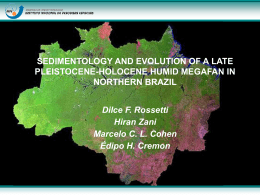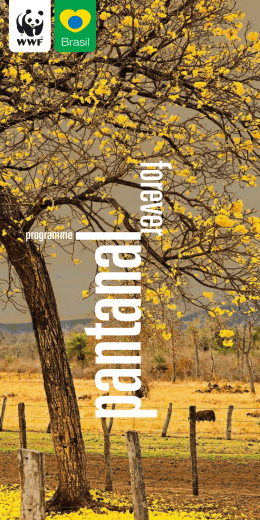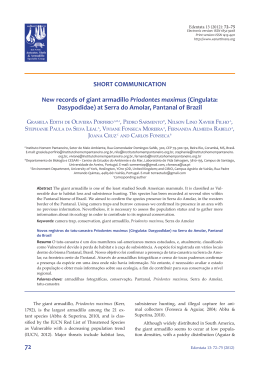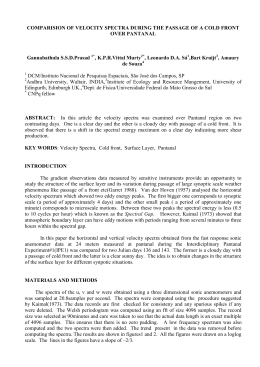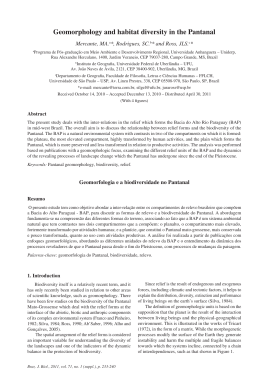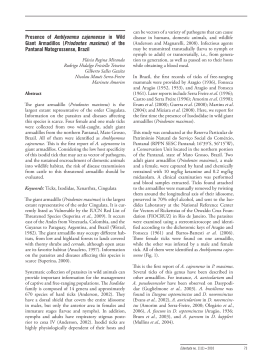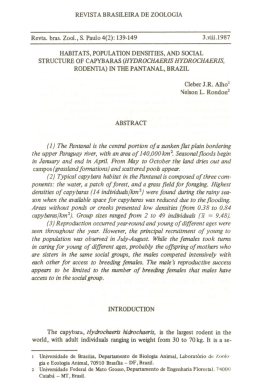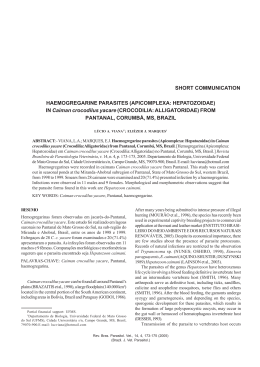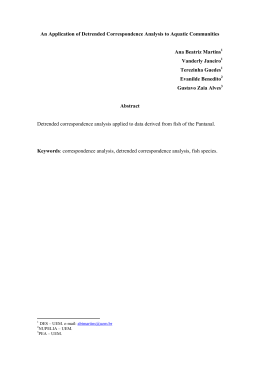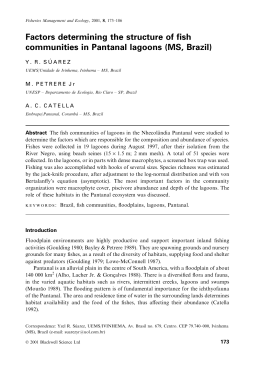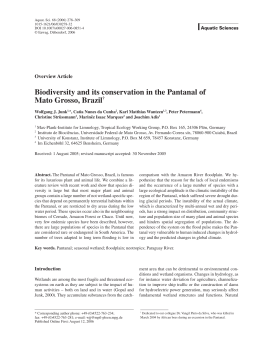Ecology, Evolution and Sustainable Use of Tropical Biodiversity 18-22 June 2012 Bonito Convention Center, Bonito, Mato Grosso do Sul, Brazil SYMPOSIUM 6: DIVERSITY AND ECOLOGY OF THE PANTANAL Bonito, 19th June 2012 (Tuesday) Pia Parolin (University of Hamburg, Germany) Catia Nunes da Cunha (INAU Cuiabá, Brazil) The Pantanal is the largest contiguous wetland in the world. It bears an immense diversity of organisms which are adapted to the extreme hydric changes in the annual cycle. Plants and animals have to cope with a regular change between flooding and drought, and even fire. A wide range of functional traits and adaptations has been evolved. Furthermore, this wetland fulfills many ecosystem services which are essential for the local people, mostly farmers, and the surrounding areas. The present symposium aims at giving insights into the status quo of the knowledge about the ecology of the Pantanal, and at highlighting the diversity of species and functions of this unique ecosystem. TALKS (Room Kadiwéu, 14h00-18h00) 14h00-14h15 (S06.OC.01) Floristic and structural aspects of seasonally flooded forests in the Pantanal and relations with flood pulse and fire. Geraldo Alves Damasceno Junior 14h15-14h30 (S06.OC.02) Environmental and spatial effects in the richness of trees and shrubs in meso-scale spatial, Pantanal, Brazil. Cândida Pereira da Costa 14h30-14h45 (S.06.P.19) Fitness and reproductive system of two Dyckia species from ironstone outcrops, Pantanal, Brazil. Gecele Matos Paggi 14h45-15h00 (S06.OC.04) Dendroecological studies of Tabebuia aurea and Tabebuia heptaphylla at the Pantanal of Mato Grosso State, Central-West Brazil. Patricia Leite 15h00-15h15 (S06.OC.05) Phylogenetic structure of Southern Pantanal plant communities. Nicolay Cunha 15h15-15h30 (S06.OC.06) Cattle impacts on forest understory plant communities of the Pantanal. Maria do Carmo Andrade Santos Coffee Break 16h30-16h45 (S06.OC.07) Cattle impacts on native mammals and birds visiting fruiting trees in southern Pantanal forests. Alexine Keuroghlian 16h45-17h00 (S06.P.03) Structure of two monodominant communities and association with soil and flooding in the Pantanal, Brazil. Geraldo Alves Damasceno Junior 17h00-17h15 (S06.OC.09) Drivers of mammalian diversity in the northern Pantanal. Vinicius Augusto Galvão Bastazini 17h15-17h30 (S06.OC.10) Conservation benefits of rotational grazing for Pantanal wetlands. Donald Eaton Symposium 6: Diversity and Ecology of the Pantanal 17h30-17h45 (S06.OC.11) Pasture management and maintenance of habitat and species diversity: perspectives for the conservation of the Pantanal. Catia Nunes da Cunha 17h45-18h00 (S06.OC.12) Behavioral responses to simulated predator presence on black howler monkeys (Allouata caraya) in southern Pantanal. Talita Araújo POSTERS (Karuha Space, 15h30-16h30) S06.P.01. Visitors of a saline lake in the Pantanal-Nhumirim Reserve experimental station. Juliana Labre S06.P.02. Analysis of relatedness of white-lipped peccary (Tayassu pecari) herds from the Brazilian Pantanal. Danilo Aqueu Rufo S06.P.04. Dynamics of Cambarazal - a monodominant flooded forest of Vochysia divergens Pohl (Vochysiaceae) - in North Pantanal, Mato Grosso State, Brazil. Fernando Pedroni S06.P.05. General aspects of breeding biology in Vespertilionidae species (Chiroptera; Mammalia). Eliane Vicente S06.P.06. Phenology and diversity of amphibians in a region of the Southern Pantanal, Brazil. Vanda Lucia Ferreira S06.P.07. Interspecific relations between hematophagous bats Diaemus youngi, (Anodorhynchus hyacinthinus) and Ramphastos toco in macaw nest cavity sites. Eliane Vicente S06.P.08. Fish species richness in marginal lakes of Miranda river, MS, Pantanal. Juliana Labre S06.P.09. Nucleation process promoted by mistletoe in the Brazilian Pantanal and Caatinga. Elâine Ribeiro S06.P.10. Experimental evaluation of Attalea phalerata seed predation along a gradient of palm density in the Brazilian Pantanal. Cecilia Siliansky de Andreazzi S06.P.11. Pantanal flooding pulse affects metazoan parasite assemblages of two host fishes. Karla Magalhães Campião S06.P.12. Visibility and rate predation of artificial nests in Southern Pantanal. Talita Araújo S06.P.13. Metazoan endoparasite communities of Leptodactylus chaquensis and L. fuscus (Anure: Leptodactylidae) in Pantanal, Mato Grosso do Sul, Brazil. Fernando Paiva S06.P.14. How well adapted are cleaning birds to cattle in the Pantanal, Brazil? Daniel Irineu de Souza Dainezi S06.P.15. Evaluation of niche and neutral effects on anuran communities in the southern Pantanal, Brazil. José Luiz Massao Moreira Sugai S06.P.16. Effect of sampling quality on patterns in community structure: a case of lizards in the Pantanal, Brazil. Juliana Terra Ecology, Evolution and Sustainable Use of Tropical Biodiversity 18-22 June 2012 Bonito Convention Center, Bonito, Mato Grosso do Sul, Brazil S06.P.17. Community structure of tadpoles in the Pantanal, Nhecolândia region. Daiene Louveira Hokama S06.P.18. Do foreign mammals contribute to maintain populations of the tick Amblyomma cajennense in the Brazilian Pantanal? Vanessa Nascimento Ramos S06.P.20. Flower number and bird florivory in Inga vera (Fabaceae) trees in the Pantanal. Breno Leonel S06.P.21. Use of artificial nests by hyacinth macaws (Anodorhynchus hyacinthinus) in the Pantanal: fourteen years of management for conservation. Neiva Maria Robaldo Guedes S06.P.22. Nesting behavior of the Neotropical coati (Carnivora: Nasua nasua) in southern Pantanal. Juliane Saab de Lima S06.OC.08. Richness and abundance of birds and terrestrial small mammals in Cambarazal forests of different ages. Mônica Aragona S.06.OC.03. Distribution, richness and turnover patterns of Poaceae in the Pantanal of Poconé, Mato Grosso. Luciana Rebellato
Download
